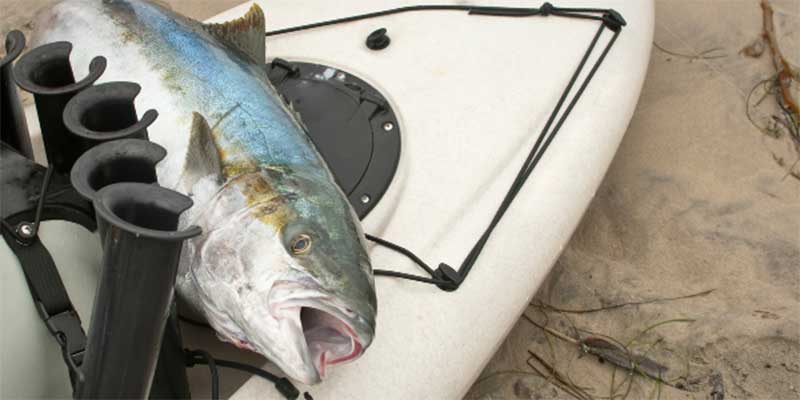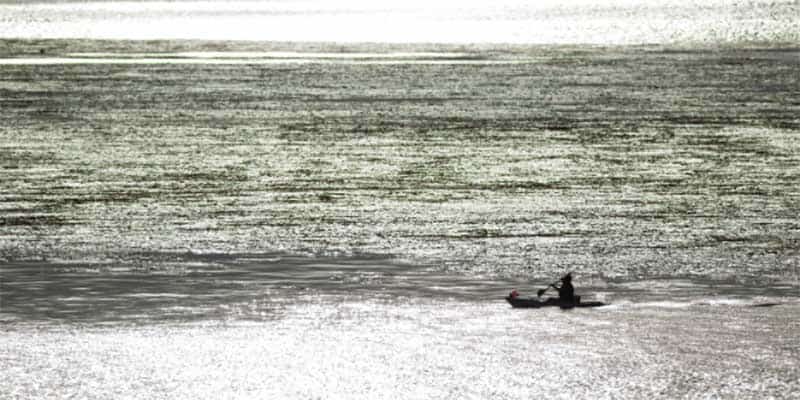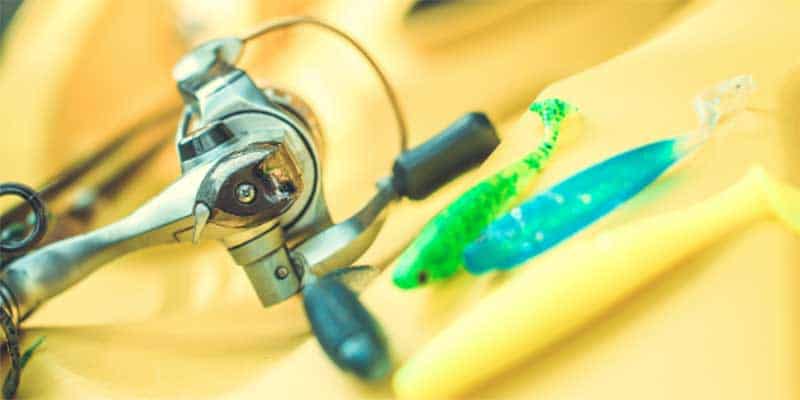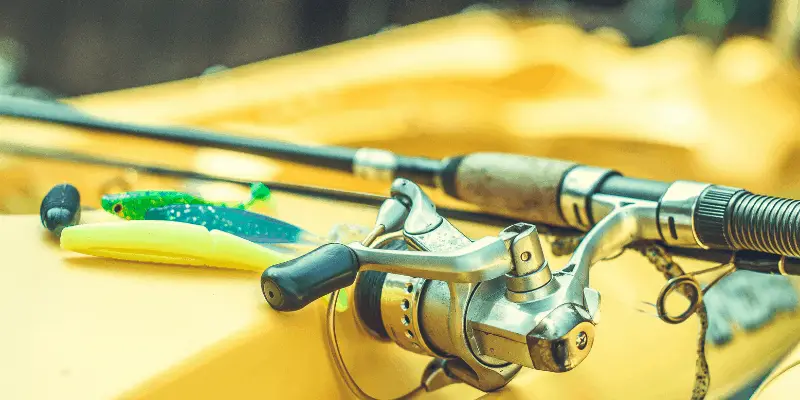Affiliate Disclosure: As an Amazon Associate, I earn from qualifying purchases.
If you’re in the market for a fishing kayak, this article will answer pretty much every question you are likely to have. I’ll cover topics such as what to look for when buying a fishing kayak and how to choose the best one for saltwater as well as fresh.
You’ll also learn about different types of fishing kayaks, which ones are better suited for beginners, and where to find them at an affordable price. I’ll hook you up with a few fishing kayak safety tips as well.
Ready? Let’s dive in.
What Are Fishing Kayaks?

Fishing kayaks are a specific type of boat often used for fishing. They come in six major types: sit-on-top fishing kayaks, sit-inside fishing kayaks, pedal drive fishing kayaks, tandem fishing kayaks, inflatable kayak fishing boats, and motorized fishing kayaks.
The main feature that distinguishes fishing kayaks from regular ones is that fishing kayaks are usually wider. Some use a sit-on-top design, and all fishing kayaks are customized to accommodate the gear needs of the fisher. Some examples of these features include a larger deck space, rod holders, and storage compartments.
A fishing kayak is usually between 10 to 14 feet long. Recreational kayaks usually range anywhere from eight feet all the way up to 23 feet. The width of a typical fishing kayak is about 35inches. This is in comparison to the width of a touring (22″-25″) or recreational (26″-30″) kayak. The wider hull means more stability but usually less speed.
Every type of fishing kayak has different advantages. There is no such thing as a perfect fishing kayak for everyone because they vary in price range, size, weight capacity, ease of use, and skill level required to operate them.
I’ll provide some more details below on the six most popular types:
Types of Fishing Kayaks

Sit-on-Top
These boats have three main parts; the seat, center console, and hull. The hull is made out of plastic or fiberglass with an opening at one end to enter into it. A small flip-up deck can be added on top onto some models for storage purposes or extra stability. Some allow you to stand up straight on them. Sit-on-top kayaks have a wide hull with open sides that allow easy access into or out of the boat from either end at all times without removing gear first. This makes sit-on-top fishing kayaks ideal for beginners who want to try paddling before committing to buying a more expensive model.
Sit-Inside
These boats have the same three main parts as a sit-on-top, but are enclosed. They provide even more stability and protection from elements while still allowing for maneuverability
Pedal Driven
These fishing kayaks use pedals to move forward. This is an advantage because it allows fishermen who don’t want to paddle with their hands to stay in position without having to constantly make adjustments. They also allow fisher men and women who may not be able to keep paddling with their arms due to health conditions or age. Pedals also allow them to stay in position without having to constantly adjust their seating position as they paddle.
Tandem Fishing Kayaks
Tandem models allow two people of similar weights or sizes (or one person on either side) to share the weight equally and help each other balance when they’re paddling. They typically offer twice the surface area which means you can store more gear inside them! Most tandem fishing kayaks have seats that face each other with a center aisle.
Inflatable Kayak Fishing Boat
These kayaks consist mainly of an inflatable tube sealed along its edges. They are often fitted with a drainage system that allow water to escape from inside as well as protect against tipping.
Motorized Fishing Kayaks
A motorized fishing kayak will be fitted with a simple electric or manual trolling engine. The motor can propel the boat through water like an outboard, so you move around without you having to do any work at all. This lets you concentrate on the task at hand – catching fish!
Fishing Kayaks for Kids
Some people want their kids to get in on the act of going fishing while they’re still young enough not to have much experience paddling themselves
A fishing kayak is also perfect as it’s lower than your average model which means that if children fall over in them, it doesn’t hurt nearly as bad! They also have stability rails so if anything should happen then there are some backup points for added safety.
Fishing vs Recreational Kayaks
The fishing kayak and the recreational kayak are very different boats. As stated earlier, the main difference between fishing and recreational kayaks is that fishing kayaks are typically wider. This is what makes them more stable and gives them added buoyancy.
Fishing kayaks also have a higher freeboard, a flatter bottom, and are made of tougher materials that can withstand minor impacts with rocks or other boats. They also have compartments to store your gear on board and stability rails for to give you added support when trying to reel in that prized bass! Recreational kayaks, however, are much smaller and lighter than fishing kayaks which make them easier to transport. They are also less stable in choppy waters.
Many fishing kayaks also have space behind the seat for storing extra equipment like fishing nets or tackle boxes. This means everything is right at your fingertips when needed but stored out of sight otherwise.
How to Choose a Fishing Kayak You’ll Love

The first thing to do is think about how often you intend on using your kayak. If you’re intending on taking it out once per year, then you may want to go with an inflatable model. If you plan on doing more than that, consider the following:
- What size boat are you looking for? Another consideration is whether or not this would be used as a recreational activity only and therefore needs something lightweight and easy to transport – or if you would need durability for sea fishing and/or prolonged use
- How much weight can you carry when fully loaded with gear and fuel onboard? If your kayak has a lower capacity than what you need then this could be a problem.
- How much storage space do you need? Some models are much more compact than others. The carpenter’s golden rule holds true here measure twice cut once! Can you store it in your shed or garage? Don’t get more kayak than you can store.
- How deep is your intended water depth? If it’s shallow, then there might be less need for durability or storage space but make sure it still has the ideal weight capacity and stability to support your fishing way (models can vary in this regard).
- Is speed something of importance? Some models offer higher speeds due to their type of design – which could also mean they’ll cost more than others
- Does the model come with rod holders already installed?
- Is there a drainage system for the cockpit?
- Does it have extra features you need? Do you want an anchor trolley or a foot brace that is designed to allow standing while paddling?
- Is there are fish finder onboard? You can buy this separately but these can be super handy to help you locate where there are fish under the boat.
What Length Fishing Kayak Do You Need?

The length of a fishing kayak is something you’ll need to consider before making a purchase. A longer boat will usually have better performance, but these can also come with some disadvantages for many types of fishermen – such as not being able to get into tight spaces or be at ease in shallow waters while paddling.
If this sounds like it might apply to your situation then read on:
Are you going out for long periods? If so, seek out the longest model available that still has enough weight capacity for you and your gear.
Is speed important? For those who prefer kayaks with high speeds- the longer models are usually the best choice.
Do you often enter shallow waters? Some kayaks are more suited for this than others so be sure to keep your needs in mind before choosing a model.
The length of your boat is an important factor when it comes to fishing kayak selection, but there’s plenty else that goes into making a decision on which one will work best for you and your needs.
The last thing to consider when buying a fishing kayak is the types of water you plan to fish in. Although it is possible that any type of boat could work well as long as there is an area available to use it on, we recommend taking into account what types of water conditions you will be spending most of your time on before picking out the right kind. To figure this out, think about where you fish or swim most often – lakes, ocean beaches, or rivers? This is a key decision point as many kayaks are designed for specific water conditions.
What Kind of Weight Capacity Do I Need?
Depending on your individual needs, you will need a kayak that can hold the weight of both you and all the gear. If speed is important to you then look for models designed with higher speeds in mind just be sure not to compromise when it comes to other features like being able to enter shallow waters or take longer trips out into open water.
Tips for Using and Maintaining Your New Fishing Kayak

In this section, I’ll give you some tips for using and maintaining your new fishing kayak.
Always store your kayak in a dry and well-ventilated area. Don’t leave it out near the water where you can easily get caught in rain, hauled away by waves, etc. Take rising tide levels and also weather and other factors into consideration.
If you are storing the kayak for extended periods (such a the winter season) make sure to plug any holes as this will help prevent mold or mildew from forming inside of it over time.
Before paddling, make sure to dry the inside of your kayak. This will reduce any damage from mold and mildew as well as improve the performance of the boat by preventing water buildup on surfaces that can slow you down or impede your stroke.
Inspect all surfaces before each use for signs of wear so that it’s easier to spot potential major repairs in their early stages.
Keep an eye out for cracks in seams, broken locks/latches, etc. These should be repaired as soon as possible.
When shopping for a fishing kayak, look for models with replaceable parts like seats, footrests, etc. Replace broken parts as early as possible. This will ensure a longer lifespan which is always better when investing money into something new!
Fishing Kayak Safety
Is Kayak fishing dangerous? No, if you practice common-sense safety measures that apply to most forms of boating, kayak fishing is not dangerous.
Some people argue that it can be more difficult to get back in a boat if you fall out than with other methods of paddling because the boats are very low-profile and may require assistance from others or another type of floatation device like an inflatable life jacket. The US Coast Guard recommends that kayaks should be equipped with a personal flotation device for each person on board.
Some people who regularly fish from kayaks say that they are more likely to fall out of the boat because they stand up or move about in it frequently. Remain calm even when you hook a fish as rocking and thrashing about can cause the boat to flip. Again, if you have your life jacket on you will be good. Flip the kayak back overthrow your paddles inside and you will be back in business.
Others argue that fishing from kayaks is safer because of the wider hull of the boat making them less likely to flip over. Practice common-sense safety tips to make your kayak fishing runs safe and enjoyable.
I like bringing my mobile phone with me in a plastic waterproof bag in case I need to call someone in an emergency. I also have a loud air horn that I could potentially use to signal someone onshore or larger boaters if they get too close. Bring sunscreen with you and apply regularly while you are out on the water. Nothing ruins a fun day of fishing like a nasty sunburn.
FAQs About Fishing Kayaks
Can You Use a Regular Kayak for Fishing?
This is the question that many people have. The short answer to this question is “No.” A regular kayak just does not offer enough stability for fishing, whether it be from a stationary spot on an island or while moving around in open water. You may feel like you can handle sitting up and staying still in your regular kayak but as soon as you start paddling, things will change dramatically.
Your back might begin cramping or your feet will swell too much because they are pressed against the footrests of the seat – these are all simply common problems when trying to fish with a regular kayak. Regular kayaks also lack features such as storage compartments and rod holders which make them less than ideal.
Is a Canoe or a Kayak More Stable?
Another common question people have is whether a fishing kayak is more stable than a canoe. The answer to this question is yes! Like a regular kayak, a canoe would be more prone to tipping. Fishing kayaks were designed with stability in mind and they are equipped with more features that help them stay upright.
One major advantage of a kayak over a canoe is the ability to use your feet for balance when needed. This feature will come in handy if you’re trying to land big fish or workaround rocky areas which can be very tricky without using foot braces and handles on the side of the boat.
Are Fishing Kayaks Slower than Regular Kayaks?
The short answer is it depends on the kayak but, generally speaking, yes. Fishing kayaks are usually heavier with more features and accessories which can make them a little slower than regular kayaks. If you’re interested in speed, consider getting a lighter fishing kayak without all the extras to maximize your paddling power!
What is Better a 10ft or 12ft Kayak?
The most common size of fishing kayaks is around 12 feet. However, you should consider a smaller or larger size depending on your height and weight as well as the type of fish that you are trying to catch.
What is better: a ten-foot-long fishing kayak or a twelve-foot-long one? It depends! The most common length for this style of boat is about 12 ft but it can vary between 11ft and 13ft in some cases. If you’re taller than average, then a longer kayak will be more comfortable for paddling because it’s less tiring over time. And if you weigh more than average, going with something shorter may be easier so that there’s an even distribution of weight across the boat.
What are Fishing Kayaks Made Of?
Fishing kayaks are typically made of a tough material that can resist damage from rocks, coral, and other sharp objects. Fiberglass or plastic boats offer better visibility in the water for catching fish while composite materials such as carbon fiber may be more resilient against impact.
The most common types of fishing kayaks are cedar or canvas which can provide an authentic look but they do not last very long without constant maintenance. ABS boats (often used by military personnel) also have some benefits because they are resistant to corrosion. They also have incredible durability with little upkeep required over time. When looking at boat options, you should take into account how much weight will impact your purchase decision. Heavier people often choose polyethylene construction because these boats usually float better.
What is the Best Fishing Rod for a Kayak?
You don’t need to buy a special rod for your kayak. However, many kayakers like to have one that is rigged for fishing purposes. Many kayakers like having a rod rigged specifically for the activity instead of using a universal rod and reel set-up: it’s just something more personal in touch when on the water! These are designed to attach to the kayak so you can use them for trolling.
With a kayak, you can’t always use the same bait that you would on land. You don’t have as much room to work with your hands and it’s also more difficult for fish to see what is happening. What does this mean? It means that you need different tools than if you were fishing from shore! Lures are certainly easier to deal with than live bait when you are out of the water. And make sure you have a bobber to prevent the line from getting snagged on the bottom while trolling.
Do I need any special gear when fishing from my Kayak?
A question that comes up a lot is around recommendations for kayak fishing gear.
What is the most important piece of fishing gear?
The answer to this question will depend on your situation and what type of kayak you have. Some people recommend that everyone has a good rod with proper line, lures, or bait for their preferred style and haul. Others may say that reel and tackle are equally as important, while others might not think they need any additional equipment at all! You’ll find different opinions out there but here’s my take: it can’t hurt to be prepared so having some basic supplies like extra hooks, sinkers and jigs is always wise.
What Color Kayaks Attract Sharks?
Cue up the theme from Jaws. What color boats will attract sharks?
If you want to avoid an entanglement with sharks, stay away from blue kayaks. Sharks are attracted to the color blue and will come closer if you’re in a vessel of that color. If your goal is to shark fish from your kayak, well, you may want to think about getting “a bigger boat.”
Does Fishing Kayak Color Matter?
What color kayak should you use to attract fish? Is there any truth to the rumor that certain colors scare fish away? The answer is yes and no. There are some colors that tend to scare off fish, but it is not always the same color as the water around you. For example, if your fishing boat is bright orange, it’s going to be hard for a fisherman in blue jeans on a green pond with an olive background of trees and bushes to catch anything! So what does this mean for you when choosing your next fishing vessel? Read on and find out!
The best color boats to attract fish are blue, silver, and black. The color blue is most often the best choice because it mimics an underwater environment where fish feel safe from predators. It’s also a calming color that hides any signs of blood or bait.
Silver boats are good to use if you’re fishing in clear water with no vegetation like beaches or lakeshores – they tend not to scare off the fish as much as other colors would do. Black is another great option for being less noticeable by potential prey when on calm waters; however, dark colors may show signs of blood or bait so be cautious when using this type of kayak if your objective is catch mackerel!
If your primary goal is catching large numbers of smaller species (like trout) then bright-colored boats are your best option. They are very visible in murky water and stand out against the rocks when deep-sea fishing as well.
A final word of advice is to avoid using pink or red if you’re going after fish like shark, tuna, kingfish – these colors tend to scare them off because they mimic large predators that would normally be a threat to their survival!
To summarize:
Blue kayaks can attract more species than any other color. Black boats generally have less visibility but may show signs of bait/blood while dark-colored boats should only be used on calm waters where it’s difficult for prey from seeing your boat coming so close. Brightly colored boats will need lots of care and maintenance to stay looking great while also will scare off some species of fish.
How To Winterize Your Fishing Kayak
Follow these four basic tips to winterize your fishing kayak.
First, cover the boat with a tarp to keep out moisture and other debris.
Second, drain any water from the boat and all gasoline from your fuel tank if you have one into an approved container. If the kayak has any moisture before you store it; you could attract mold. Let it sit out in the sun for a few days and wipe down any excess moisture with a large towel.
Third, remove any fishing equipment you have onboard so it does not rust or corrode during storage.
Finally, plug up air intakes at the bow of the kayak such as scupper holes for drainage plugs. Again, less air means less likely to attract mold—or critters!
Popular Fishing Kayak Brands
If you’re in the market for a new kayak, there are some great brands out there to choose from.
Some top brands of fishing kayaks are Ocean Kayaks and Pelican which produce both sit-on-tops as well as traditional kayaks that paddle with double-bladed paddles or single-blade paddle depending on preference.
Old Town produces iconic boat designs like the Otter and Chesapeake series while Wilderness Systems provides high-quality boats such as their Tsunami 160LR model which is widely used by fishermen because it’s so easy to maneuver in shallow waters!
My Ultimate Guide to Fishing Kayaks: Your Take
I hope you found this guide helpful.
So what are your biggest concerns in choosing a fishing kayak? Do you like the sit-on-top or sit-inside models?
Do you have any additional tips other readers of this article will find useful?
Please leave a comment below and let us know! Until next time, be safe out there – and happy fishing!


